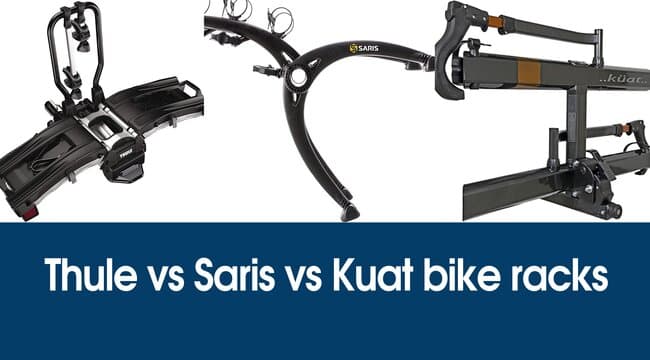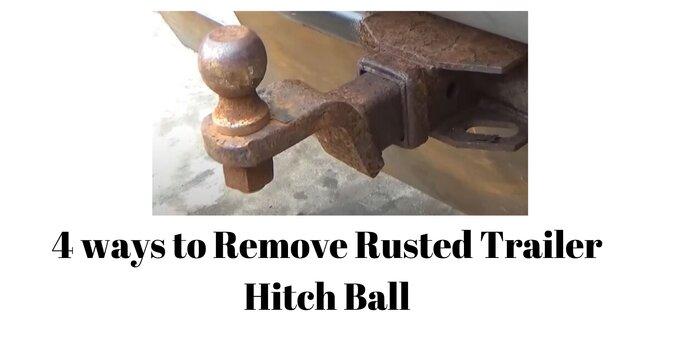Nowadays a common question to be asked can we put a 5th when on trucks that have flatbeds? If yes, what hitches are the best and we can properly install these hitches on our truck? Multiple diverse installation methods must be followed to install a 5th wheel trailer hitch on a flatbed. So, let’s define these problems and talk about the solutions in-depth. So, keep reading the article for further information.
Is it possible and safe to put a 5th wheel hitch on a flatbed truck?
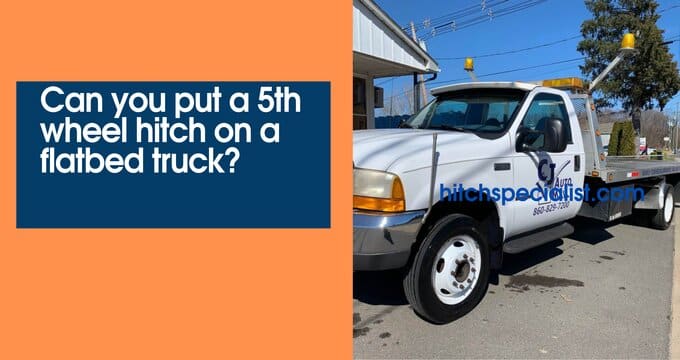
Yes, a 5th wheel hitch can be installed on a flatbed truck. But you need to install some other ingredients like a good 5th wheel connector for that. All the trucks won’t be the same. Because most flatbed trucks are not the same as other trucks and they must carry weight based on their manual and proper weight distribution, you’ll need to examine the shape and size of the trailer or camper you’re towing.
Some fifth-wheel trailers and hitches are designed expressly for trucks with flatbeds. There will be a few driving tweaks and adaptations to how the hitching is done, but it shouldn’t be too difficult.
What is the best flatbed 5th wheel hitch on the market?

Andersen’s hitches are the best in the market till now. Different tow vehicles necessitate different fifth-wheel trailer hitches. Andersen Ultimate 5th wheel hitch comes in a variety of styles to ensure a perfect fit for your vehicle. The Ultimate is the best fifth-wheel hitch for a reason, and it has earned its distinction as the ultimate in fifth-wheel hitches. It’s simple to attach to your trailer, and it works with any gooseneck ball design in your bed.
Also read:
How to mount the 5th wheel on a flatbed truck? (step by step)
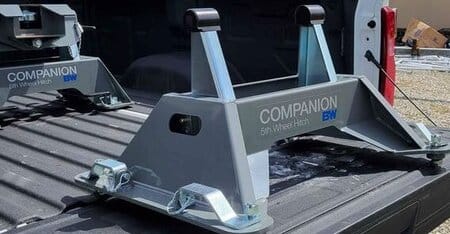
These are the steps that will help you to install a 5th wheel on your flatbed truck:
Tools require
- Plumb bob: The first thing you need is a plumb bob. which is just anything from hanging from a cord.
- Tape: A tape measure is also needed something to mark with.
- Hammer: A hammer is needed while running the operation and a Spring-loaded center punch.
- Drill machine (Optional): A drilling machine may be needed in case you need to make any holes. It’s good if any professional does this.
- Wrench: You will need a ¾ inch wrench, same size socket, and ratchet
Steps to be followed:
Step 1: If there are any spare tires, remove it
Access to the underbelly of your truck bed is required to install a 5th wheel with brackets and base rails. To make extra room, take out the spare tire if the spare tire is located on the flatbed. You may need to remove a heat shield or other components as part of the operation. Make careful to follow the directions that came with your hitch.
Step 2: Place the front base rail in its proper place
Install the base rail closest to the truck cab, making that the distance between the front of the truck bed and the base rail is correct. This distance varies depending on whether the pickup truck is long-bed or short-bed. For specific measurements, refer to the instructions. The base rail must also be centered between the wheel wells.
Step 3: The first drill sites should be marked
Mark the bolt hole locations for the rail with a paint pen. Once the foundation rail has been properly positioned. Then, with a centerpunch, mark one of the drill holes. In a subsequent step, the other bolt locations will be marked. The center punch will assist restrict the drill bit from wandering by pinpointing exactly where to drill. Finally, a pilot hole should be drilled through the designated spot.
Step 4: Examine the pilot hole beneath the bed
Position the proper under-bed 5th wheel bracket in the pilot hole you just drilled for the time being. The remaining bolt holes can be drilled if the bracket lines up appropriately with the hole. Move the base rail out of the way, center-punch the drill positions, and drill down from above the truck bed.
Step 5: Increase the size of the bolt holes
Drill the pilot holes with a step bit until they are large enough to receive the 5th wheel rail bolts. Drill gently and thoroughly.
Step 6: Install the brackets under the bed
The under-bed brackets should be placed on either side of the truck bed. These are usually placed from the opening in the wheel well. Place the proper bracket or brackets in place and use the accompanying nuts and bolts to secure them to the truck’s frame. Then, on the other side of the truck, secure the other bracket.
Step 7: Install the fifth wheel rail
In the truck bed, reposition the base rail over the appropriate bolt hole positions. Spacers may be included if the truck has bed rails at the bottom of the bed. To provide consistent metal-to-metal contact, place these under the fifth wheel rails and between the truck bed rails.
Step 8: Measure the height of the fifth-wheel hitch
Your 5th wheel hitch must be set at the right height to accommodate your vehicle bed. Your truck bed walls and the trailer must be at least 5-1/2″ apart in height. Make sure your trailer is situated on a level surface before measuring the hitch height. Here’s how to do it:
1. Measure from the ground to the kingpin plate’s underside.
2. Measure from the ground to the top of your truck’s open tailgate.
The recommended height for your 5th wheel hitch is 1 minus 2.
Step 9: Connect the fifth wheel’s legs
Find the correct mounting holes on your 5th wheel hitch head to accommodate the required height after measuring the hitch height. Most 5th wheel hitches have a vertical adjustment range. Place the legs on top of the head and fasten them with the provided bolts.
Step 10: Place the fifth wheel rail in the back
After you’ve installed the 5th wheel hitch, you can simply locate the location for the second, rearward base rail. Lift the 5th wheel hitch into place with the help of a friend or an expert, then put the legs into the base rail you’ve already installed. Then, using the leg anchors on the 5th wheel hitch as a guide, place the second base rail in the proper spot.
Step 11: Drill holes for the foundation rail on the back
Make sure the second foundation rail is centered in the truck bed, between the wheel wells, before marking the drill positions. Then, using a paint marker, mark the drill sites, move the rail out of the way, center-punch, and drill pilot holes.
Step 12: Secure the rear base rail with bolts
Place the second fifth wheel rail in place and screw it down using the provided bolts through the holes you bored in the truck bed. The bolts will go through the rail, the truck bed, and the already installed under-bed brackets. The nuts for fastening the bolts will need to be placed from underneath the truck bed, just as the first base rail.
Make sure you use any spacers or additional hardware that the instructions call for.
Step 13: Any remaining bolts should be installed
Supplemental bolts must be put in both rails in some 5th wheel installations for further security and strength. It is not necessary to mark the drill positions. Simply center-punch, guiding yourself with the rail. Drill pilot holes and then use a step bit to expand the holes.
Step 14: All hardware should be torqued
It’s time to thoroughly tighten the bolts after the base rails have been installed with all essential hardware. This will necessitate the use of a torque wrench. The torque values for each bolt size are listed in the installation instructions that came with your hitch.
Final Step: Reinstall the 5th wheel hitch and you’re done
Return the 5th wheel hitch system to its original location, nestled between the completely installed base rails. If you haven’t yet torqued the hardware on the hitch, now is the time to do so. Before hooking up to tow, double-check that all necessary pins and other components are in place.
Things you should remember before towing 5th wheel hitch on a flatbed truck
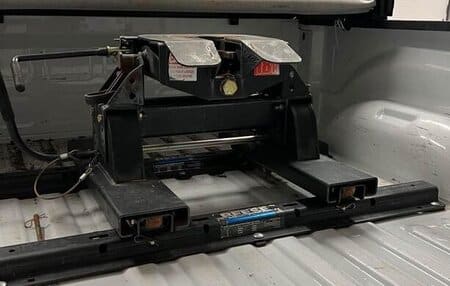
Maintain a sense of control
Examine your vehicle’s towing capacity and be sure it can handle the weight of your trailer. When towing capacity is exceeded, unsafe handling can occur.
Make sure your trailer is adequately packed.
It’s critical to not only keep within the trailer’s maximum weight capacity but also to ensure that any cargo is appropriately positioned.
Examine your tires properly
This applies to your tow vehicle as well as your trailer. Inadequately pneumatic tires can hurt handling.
Examine your brakes and lights
Smaller, lighter trailers may not require any form of trailer brakes, but larger trailers, or those meant to transport bigger loads, will almost always have one. So, try to check your brakes and trailer lights as well.
Make any necessary adjustments to your mirrors
Before you go, ensure sure your side-view mirrors are adjusted to provide a clear view of the trailer’s end.
You can also watch this flatbed 5th wheel hitch installation video by Greg Folwell:
Conclusion
Having a flatbed truck is not a problem anymore once you have the proper knowledge that how to hitch it properly. In the discussion, we hope that we were able to fulfill your queries. Try to maintain these guidelines properly which are given above and try to maintain all the steps properly. Have a safe journey.
Also read:

